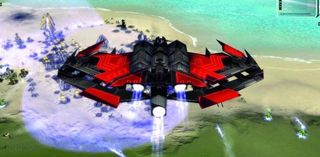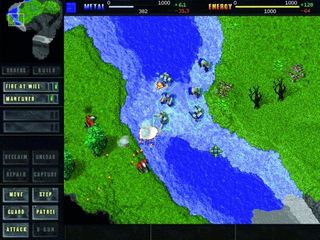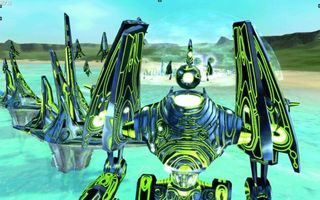The making of Supreme Commander

This article originally appeared in issue 249 of PC Gamer UK. It's been updated slightly to reflect Gas Powered's fate.
There's nothing quite like Supreme Commander. It's a real-time strategy game on a scale normally reserved for turn-based campaigns. A thousand robotic tanks and walkers of varying sizes stomp across country-sized maps, and every shot is physically modeled. It has three factions with 60 unit types each, monstrous top-tier units the size of city blocks, and unnaturally smart AI to fight against. And it's pretty much what designer Chris Taylor set out to make: the biggest ever RTS.
In a lot of ways, it was an extension of ideas that started with Total Annihilation. While working at Electronic Arts, Chris had been itching to make an RTS. The genre was still young at the time, and dominated by Warcraft and Command & Conquer – both flat, 2D games built to a very similar template. Chris wanted to make something different, and he found an unlikely person to help him: Monkey Island creator Ron Gilbert.
Ron had been making educational kids' games at his company Humungous Entertainment, but was starting to miss the world of hardcore gaming. He formed a new division, Cavedog Entertainment, to make stuff for more battle-hardened gamers. And when Chris Taylor explained his ideas for an RTS, he thought they sounded cool. Cavedog hired Chris, and Ron acted as producer on Total Annihilation.

Ron's instincts were right, Chris's ideas were cool. Total Annihilation introduced radically new ways of using resources, producing an army, and controlling it. Instead of buying new units for a lump sum, your resources decreased steadily as you manufactured new death bots in your factories. That created a new kind of economy all about balancing steady rates of income and production, rather than waiting around for gold to accumulate.
"Total Annihilation lay the groundwork for a game of a much grander scale. But it would be a while before it got made."
TA's other innovations also helped you focus your attention where you wanted: you could queue up orders by shift-clicking, and your units would follow them in sequence without further babysitting from you. That not only let you set waypoints for your attacking forces, but it also applied to build orders: you could queue up a whole base worth of buildings and your commander would just get on with it. You could even set units to patrol on a repeating route. All of this let you build and control more units with less clicking, laying the groundwork for a game of a much grander scale. But it would be a while before it got made.
Total Annihilation was a success: it got glowing reviews and earned a cult of devoted fans, many of whom still rate it as the greatest RTS ever made. But during its development, Ron sold Cavedog's parent company Humungous to publisher GT Interactive, partly to enable them to grow into a bigger company. They released new units for TA each week, developed an expansion, and started work on a sequel.
The biggest gaming news, reviews and hardware deals
Keep up to date with the most important stories and the best deals, as picked by the PC Gamer team.

Chris was involved in the early stages of that sequel, but he didn't get far with it: “I remember writing a page or two,” he says, “but that was about it. We were so busy supporting TA, releasing patches and those weekly units, we didn't have time to do much else.”
Not long after they finished work on the expansion, Core Contingency, Chris left. Cavedog had grown, but that wasn't necessarily a positive. “I might have stayed if working inside a large company was something I personally enjoyed doing,” he says, “but not back then.” He'd always wanted to start his own gaming company, and he decided it was time. “I had something to prove out in the world.”
He formed Gas Powered Games with the intention of ultimately making a successor to Total Annihilation, but decided to make a very different game first: hack-and-slash RPG Dungeon Siege. “I seem to remember not wanting any legal 'fog' hanging over GPG, so it made sense that we do something completely different. But as soon as Dungeon Siege shipped, I started shopping Supreme Commander around.”

It would be more than a TA remake or spiritual sequel. “For the most part,” Chris says, “I wanted to see how far I could push the RTS genre. I knew that I wanted to make big maps, but I wanted to see if I could make the strategic part of the game even deeper."
"I wanted to see how far I could push the RTS genre. I wanted to make the strategic part of the game even deeper."
"I have a saying: strategy happens before the battle, and tactics happen during the battle. I wanted to see if I could give the player the right context for truly employing strategy, like when the Allies were planning Operation Overlord. That was the core of my inspiration for making the game bigger than ever.”
That meant using all the smart interface inventions of Total Annihilation, improving them further, and using that elegant control system to let the player build and command armies of ridiculous size. You can not only queue up orders, but specify the formation you want your army to move in as they follow them. You can tell air transports to run repeating ferry trips to pick up and drop off every land unit who needs to get to the front lines. And you can set up perfectly balanced build orders for your factories to follow on an endless loop.

The sheer scale of the thing defied a normal RTS perspective. Top-tier units are around a hundred times the size of the standard attack bot, so no single zoom level could accommodate the huge differences in the scale of the battles you fight throughout the course of a game. “The whole idea of 'strategic zoom' didn't come up until we were into development,” Chris says. It became the game's defining feature: you can zoom smoothly from the scale of a truck-sized robot to seeing an entire 6,000 square kilometre theatre of war all at once.
"You can zoom smoothly from the scale of a truck-sized robot to seeing an entire 6,000 square kilometre theatre of war all at once."
Internally, the game's three factions were referred to as Earth, Alien, and Recycler. “The Recyclers never really felt right, because when you create a new unit in a factory from raw resources, how can that be made of spare parts?” In the finished game, all three factions are human: Earth became the UEF; Aliens became a human faction using alien technology, the Aeon Illuminate; and the Recyclers became the Cybran, cyborgs ruled by a brain in a jar.
As the fiction was nailed down, the design became more adventurous. “Ships that sprouted legs, and other outrageous stuff, all came into play after we started,” Chris says. The UEF have a giant tank that's also a factory. The Cybran, as well as the walking ships, have an artillery piece that spits a stream of shells that can level a city. The Aeon have a flying saucer as big as a city. Every faction has tactical missiles, nuclear missiles and submarines. Commanders can upgrade themselves with new weapons and abilities, including invisibility, teleporters and shields.
Just clicking on that ship-with-legs gives you some idea of Supreme Commander's complexity. Seven rings appear around the unit to show you all its different capabilities: vision, radar, sonar, main gun range, anti-air gun range, torpedo range, and torpedo interception range.

If you love big trucks, establishing trade routes, and the phrase 'post-apocalyptic survival business simulator' then I've got just the strategy RPG for you

Blizzard veteran David Kim's strategy comeback with Battle Aces is 'very personal:' 'I just can't accept... the end-all peak of RTS is StarCraft 2 and nothing can ever be better'
Most Popular

